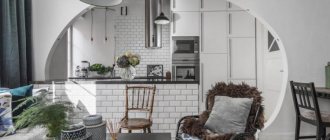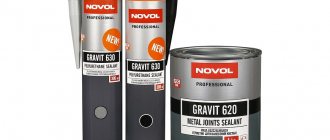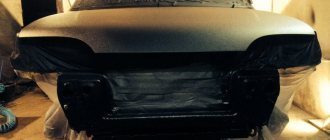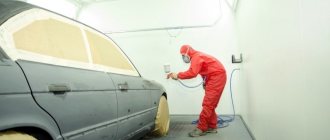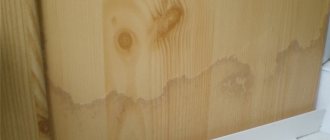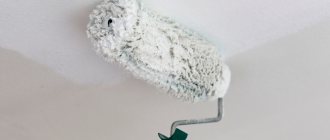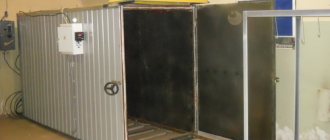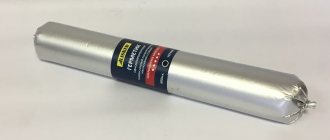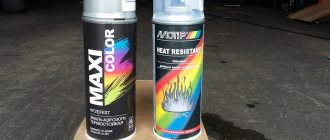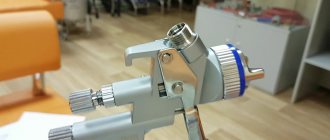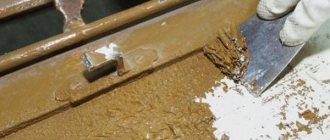Messages 4
- Basil
1 Topic from guru 2013-06-02 16:51:01
- guru
- Participant
- Inactive
- Registered: 2012-11-11
- Messages: 103
Topic: How to paint an MDF arch
We made some renovations and decided to put an arch in the kitchen instead of a door. We stopped at a hardware store and saw a variety of MDF arches. Unfortunately, none of the colors offered suited us, and we decided to buy one for painting. But now the question arose: how to paint an MDF arch? So that the structure is even, washes well and does not stink.
2 Reply from Ivanovich 2013-06-02 16:51:29
- Ivanovich
- Participant
- Inactive
- Registered: 2012-11-11
- Messages: 175
Re: How to paint an MDF arch
What does our man mean? Why didn’t you consult the store before buying? I am sure that sellers of paint and varnish products would explain and show you how to paint an interior arch made of MDF. But what we already have, as they say. In your case, I would go to the same hardware store and order water-based tinting. This way you can choose exactly the color you need.
3 Reply from Alexander 2013-06-02 16:53:04
- Alexander
- Participant
- Inactive
- Registered: 2012-11-11
- Messages: 107
Re: How to paint an MDF arch
Guys, sorry for getting off topic. Has anyone made interior arches themselves? If there are such craftsmen, then tell me how and what to make a square interior arch from. I would be very grateful for your advice.
4 Reply from builder 2013-06-02 16:53:54
- builder
- Participant
- Inactive
- Registered: 2012-11-11
- Messages: 131
Re: How to paint an MDF arch
Regarding the first question in the topic: how to paint an MDF arch. Well, the simplest thing is, if you like the look of MDF, of course, you can simply coat it with varnish or plain paint. If it’s more complicated, you can search among decorative coatings. Of course, you will have to tinker a lot, but painting an MDF arch will become not just a mechanical job, but even a creative one. Regarding the second question, how and from what to make a square interior arch. The simplest material from which you can make an arch is drywall. Everything is done simply - you make a frame from metal profiles, cover it with plasterboard, putty, sand, prime and paint. How to paint an interior plasterboard arch is not a question at all. How and what you want. It is best to do this with water-based paint using a roller. You can also cover it with ordinary wallpaper or with bamboo.
How to paint drywall - paint walls correctly at home
Drywall has gained immense popularity recently, so it is now very difficult to imagine carrying out any repair work without this building material. Drywall is intended for leveling walls and ceilings; it can be used to create various original structures, including arches or multi-level ceilings. All work associated with the installation of gypsum boards is quite simple. However, the finishing may raise some questions. In today's article we will figure out how to paint a surface made of this material, as well as the features of painting drywall.
There are many options for finishing drywall. Painting plasterboard walls is still considered the most popular. Before you start painting walls and ceilings, you need to prepare the surface for these procedures. So, it is imperative to putty the sheets, carefully prime them, and also sand them. Only after this can you proceed directly to the staining process.
Before painting, drywall must be prepared
First, we’ll help you decide which paint for drywall is best suited. Let’s immediately discard options with oil-based paints, since such compositions practically do not interact with drywall. To make the gypsum plasterboard surface look very beautiful and stylish, and not lose its attractiveness for a very long time, it is recommended to use water-based paint or regular water-dispersion paint.
Dispersion compositions boast remarkable durability and moisture resistance; moreover, mechanical damage, such as scratches, will be almost invisible to the eye on such a wall. The only drawback, but a very serious drawback, is the extremely limited color palette. The problem is that dispersion paints for drywall are only available in light shades.
The same cannot be said about the water-based solution. The choice of colors is very large; you can find paint in bright, saturated colors, as well as lighter and calmer ones. Naturally, such compositions are much more popular, because with their help you can decorate a room in any style, the only limitation is your fantasy and imagination. The only negative point here is durability - water-based emulsion requires periodic updating on walls or ceilings.
Experts advise paying attention to the following compositions, which are varieties of the paints described above:
- Latex paint is an excellent choice, because this paint was created almost specifically for drywall surfaces. The use of such a composition will provide reliable protection from moisture and resistance to contamination. However, the cost of latex is very high, which forces some buyers to turn their attention to other options.
- Acrylic paint - for example, you can use this option. Acrylic compositions have such qualities as durability and reliability, as well as ease of maintenance. Thus, a surface painted with acrylic is very easy to clean; you just need to wipe it with a damp cloth to get rid of possible dirt or any other deposits. Paint made on the basis of acrylic practically does not emit harmful and toxic substances.
- Silicate paint is a fairly expensive paint that is ideal for use in rooms with high humidity levels. When choosing how to paint drywall in a bathroom or kitchen, it is recommended to vote in favor of silicate mixtures, since with them you will forever forget about the appearance of mold, fungi and other microorganisms on the treated surface.
It is recommended to use water-based or water-dispersion paint
Another type of paint that has appeared relatively recently is universal silicone mixtures. Manufacturers have managed to combine all the main positive qualities inherent in silicate and acrylic materials. As a result, silicone paints are suitable for use in bathrooms and in ordinary rooms, protecting against external factors, providing the maximum level of durability, reliability and maintaining an aesthetic appearance. An important advantage of silicone materials is that they make it possible to seal relatively large cracks in drywall, up to 5 mm in thickness.
Drywall is a man-made material based on compressed gypsum. If you actively rub a piece of such a product, it will turn into dust in just a few seconds. Therefore, gypsum board sheets must be prepared and treated with various primers before painting with one of the above paints.
After installing plasterboard sheets on the wall, there are seams, the dimensions of which depend on the skills of the craftsman. However, the seams will remain in any case, there is nothing wrong with that. But they need to be sealed using putty compounds. Otherwise, after some time after painting, the surface will be covered with numerous cracks.
In order for the putty to have the greatest effect, it is recommended to seal the seams with a special reinforcing tape called serpyanka. If you apply putty in two layers, then the serpyanka is glued after the first layer - in any case, the putty should be the last layer. When gluing the tape, some requirements must be observed:
- 1. Serpyanka is attached exactly in the middle of the seam
- 2. It must be pressed down quite firmly at the junction of two sheets of drywall
- 3. Ideally, you should use a continuous tape. If only separate pieces are available, then they are glued overlapping each other.
The seams must be puttied
Having treated the seams, you can now putty the gypsum board. There are no special requirements here, everything is done according to the standard scheme. At the end of the process, plasterboard walls should be carefully sanded so that the resulting surface is smooth to the touch.
Now, finally, we’ll tell you how to properly paint drywall so that the result pleases you for a very long time. For these purposes, you can use either a roller or a spray bottle. The latter option is not so popular, which is due, first of all, to the lack of such a tool for the average person, and secondly, the spray gun requires certain skills and abilities in operation. Although professionals try to choose this particular device, since the quality of drywall painting in this case will be very high.
Most ordinary people traditionally use a roller. The length of the pile in this case plays a huge role. To obtain a brighter and richer structure, you should buy a roller with long pile. Before using this tool, it should be rinsed in clean water and dried thoroughly. However, a roller is not the only device we need when painting. So, very often there is a need for a small brush, for example, in corners, as well as hard-to-reach places. Movements with the brush should be jerky and sharp so that the coloring matter lies beautifully on the surface, without creating sagging or creating a heterogeneous effect.
It is necessary to paint the walls in stages, that is, in several layers. Moreover, a new layer is applied only when the previous one is completely dry.
Having decided what paint you will paint the drywall with, pour the mixture into a special tray with a ribbed surface, dip a roller in it and apply the paint to the wall. The first stroke should be made parallel to the window, all other movements are made in the same way as the first, overlapping, overlapping the previous stroke by approximately 15 cm.
After the first layer has dried, the second layer is applied in exactly the same way. The number of layers depends on the quality of the paint and the gypsum board itself, but it is recommended to apply at least three layers of paint. Then the wall will look really beautiful, and the result of your work will last for a very long time.
Finishing the arch is the final stage, which will highlight the beauty of the structure. It should be noted that this particular work is the most important when it comes to the decorative component. Don't worry - you can do everything completely yourself. The main thing is to show the necessary perseverance and desire. Of course, you cannot do without some experience and the availability of the necessary tools, which are selected depending on the chosen finishing option.
Of course, there are many more products for decorating arches. If desired, completely unusual options can be used. So, for example, the structure, which is lined with fitted log cuts, looks quite original. Technologically, this solution is very simple. The blanks are cut to the required size.
On one side there is a cut, which will serve as a groove for the edge of the opening. Such blocks of wood are inserted into place, secured with self-tapping screws. Unlike conventional interior doors, plasterboard arches look solemn, visually raise the ceilings and expand the space of the apartment. The plasticity of this building material allows you to cut out oval reliefs and all sorts of smooth curves from it, which complement the interior so beautifully.
A variety of plasterboard arches, their features and design functions will be discussed later in the article. Reminiscent of ancient temples and Renaissance palaces, vaulted passages add sublimity to the interior. They are great for visual zoning of hallways, corridors, landings, living rooms, and reception rooms.
The large number of geometric shapes that can be given to drywall makes it possible to choose the ideal option for any type of interior. As for the material, you will need:
- plasterboard sheets;
- self-tapping screws;
- metal (aluminum) profile (or wooden beam);
- putty;
- fiberglass mesh (can be replaced with paper tape).
of plasterboard arches shows that they are usually divided into six types:
- Classic.
- Modern.
- Romance.
- Ellipse.
- Trapezoid.
- Portal.
Advice for installing wallpaper on an arch. When decorating the outer part of the arch with wallpaper, you should slightly bend the wallpaper inward and, stepping back from the corner literally a millimeter, cut off the unnecessary piece. Having done this on both outer sides, you should stick the wallpaper on the inside of the arch. If you do everything following this advice, then the joints on the wallpaper will look a little more natural, because there won’t be that random white stripe between the sheets of wallpaper.
One of the disadvantages of this finishing material is its difficulty in installation, because laying it out takes a lot of time and effort, like all others it requires a lot of attention and accurate calculations. Another drawback is the price. Decorative stone is truly almost the most expensive of finishing materials. But the greatest advantage of such a stone is its appearance, because it’s not for nothing that it costs so much money.
Are you going to finish the arch in your apartment and don’t know where to start? I'll tell you about 10 simple ways to finish an opening, and you can choose the option that suits you. I will also offer three simple instructions for finishing wall openings yourself. Now you know how to decorate an arch yourself with polyurethane molding and other equally popular materials. If you have any questions, I recommend watching the video in this article.
Write your ideas and considerations regarding the decoration of arches in the comments.
Why do this?
Many people wonder: is it possible to paint MDF at home, and why is this necessary? The answer to the first part of the question is yes. Indeed, you can paint the panels yourself. But it’s worth making a reservation right away: if you don’t have a spray booth at hand, the result is not always ideal. The coloring procedure is necessary for the following reasons:
- Painted elements become more resistant to high temperatures and humidity. Therefore, they can be used in the kitchen and bathroom, where they can fulfill different roles.
- By decorating, it is possible to diversify a dull interior and refresh the appearance of the room. The shade is chosen based on the design ideas.
- Painting MDF panels is also necessary in order to extend their service life.
Painting MDF allows you not only to diversify a boring interior, but also to extend the life of the product.
Of course, this option also has some disadvantages. For example, this procedure is sometimes much more expensive than using decorative films. In addition, the surface becomes prone to fading.
Review of options: how to decorate a plasterboard arch
Finishing arches is a painstaking task. But if you approach this wisely, put in a little effort and creativity, then you will do without craftsmen and will be able to finish the arch according to your own design. Before work, look for information, dream up and develop a design for an arched ceiling, and select suitable materials for decoration.
To avoid making a mistake with your choice, consider the nuances below.
- relatively short service life;
- not always amenable to restoration;
- not suitable for use in areas with high levels of moisture.
Arched vaults look great in corridors or long passages where there is little light. In this case, they act as a partition, dividing a long space into functional zones.
- it is difficult to repair a separate area without changing the entire design of the arch;
- due to its embossed texture, decorative putty is difficult to care for;
- like wallpaper, decorative putty is afraid of excess moisture.
Those options for decorating arches that look ideal when exiting, for example, onto a loggia, are irrelevant for the kitchen, and vice versa. Therefore, when deciding on the finishing method and appearance of the arch, take into account its placement and other nuances. These include the design, size and purpose of the room in which you are decorating the entrance, and the function of the arch itself.
Selection of materials for painting
In principle, all paints for MDF are selected taking into account the composition of the material. And this is, first of all, a fine wood fraction, which means that paint solutions for wood are suitable for the job. But to obtain a truly high-quality coating, it is advisable to use special mixtures.
Polyurethane enamels
This material should be preferred for the following reasons:
- The coating is wear-resistant and can withstand exposure to household chemicals.
- The solution does not have an unpleasant odor, which makes it possible to carry out work in cramped home conditions.
- The mixture can be applied using a sprayer, roller and brush.
- Painting MDF with enamel is done independently; this procedure does not require professional skills.
Advantages of painting MDF
Currently, this material is actively used in the creation of furniture, interior doors, and finishing panels. And all of them are subject to painting, which acts as a decorative and finishing coating.
Its use provides the following advantages:
- The painted MDF element is not afraid of elevated temperatures - thanks to this, it is possible to use it in the kitchen, where hot dishes will be placed on it;
- Decorating in non-standard colors will help add brightness and originality to the interior of the room - it can be “metallic”, “mother of pearl” or other unusual colors;
- The absence of harmful chemical compounds is an undoubted advantage for painting MDF at home - the only condition for this is the use of high-quality paints and varnishes;
- Durability – applying paint can significantly extend the life of the product.
Of course, this method of protecting surfaces also has disadvantages. They consist in the fact that the price of painting parts significantly exceeds the cost of covering such products with decorative film. In addition, exposure to sunlight may cause the painted surface to fade.
Stages and technology of painting
The procedure for painting MDF with your own hands is carried out in several stages. They can be divided as follows:
- Grinding.
- Putty.
- Padding.
- Coloring.
- Varnishing (patination).
Completing each stage is a guarantee that the result will turn out as intended.
Grinding
Work begins with grinding the surface. This is a rather labor-intensive task that must be performed carefully.
The panels are sanded with sandpaper with grit from 120 to 240 units. The process is performed in several stages and using different materials. Everything must be done very carefully, without staying long in one area. This procedure is carried out in order to remove small irregularities, as well as remove the fine lint that covers the entire surface.
The MDF sanding procedure allows you to get rid of small irregularities on the surface of the board
On a note! If there are milled areas on the front side, it is better not to touch them. There is a good chance that the sandpaper will smooth out the corners of the design.
Puttying
Puttying MDF for painting has the goal of correcting the existing shortcomings of the panel. It happens that during grinding or due to improper storage, cracks or dents appear on the surface. To hide them, putty is used. Of course, if there are no such problems, then this stage is skipped.
The technology itself looks like this: the acrylic mixture is carefully applied to the desired area and leveled with a rubber spatula. After drying, be sure to sand it.
Padding
This stage is mandatory. It is conventionally divided into two processes:
- Applying the first layer of primer This is done using a spray gun, so the room and place for work are prepared. It is better to cover other items with cellophane film in advance.
- The mixture is sprayed over the entire surface of the panel in an even layer. This is done in order to raise the remaining pile and reduce the absorption of the base materials.
- Next, when the slab is dry, it is sanded using fine sandpaper.
- The second layer is applied in order to consolidate the result and remove remaining blemishes.
Coloring
Can MDF be painted with a brush and roller? Yes, but this should be done very carefully. There is a high probability that stains and streaks will remain on the surface. Therefore, it is best to use a spray gun.
The technology itself resembles priming. The paint is applied in several layers, each of which is pre-dried. It is important to achieve an excellent result, so the mixture begins to be sprayed from the milled areas to the edges, and then passes along and diagonally. It is much more convenient to paint smooth panels.
To paint MDF you can use brushes and a roller, but to obtain an even layer it is better to use a spray gun
On a note! To understand in more detail the drying time of the solution and its quantity, you must carefully study the manufacturer’s instructions. And also select the desired operating mode for the sprayer.
Arch installation
Tools and materials
Before you begin installing the arch, you should prepare the following tools and materials that will be needed during the work process:
- tape measure for taking measurements;
- a hacksaw for metal or a hacksaw for wood with fine teeth;
- four clamps;
- PVA glue;
- carpenter's hammer;
- level.
If an arch is installed without corner fillers, then you will need more tools and materials to create an arch in the doorway. Below I will tell you in more detail how this is done.
Arch installation
Assembly
First, let's look at how to assemble an MDF arch with corner fillings. This work can be roughly divided into several main stages:
Main stages of arch assembly
So, the work is done as follows:
- you need to start with an accurate measurement of the doorway . Moreover, measurements must be taken in several places;
- After unpacking the arch kit, you need to glue the arches together . To do this, the tongues are coated with glue, then inserted into the holes of one of the parts, and after that the second part is joined. For reliability, you can coat the ends of the parts with glue. It should be noted that if necessary, the arch can be expanded. For this purpose, the kit includes special additional decorative elements that are installed between the two halves of each vault;
- Next, you need to glue the cornices to the arches using the same principle.;
- then you need to adjust the filling plates to the depth of the opening, i.e. wall thickness . It should be taken into account that the thickness of the plates should be 10-12 mm greater than the depth of the opening so that they can fit into the grooves of the arches and platbands. To cut the plates, you need to mark each of them in the form of points along which a straight line is drawn. You need to carefully cut the plates using a hacksaw. You can use one of the plates as a guide, which should be fixed on the part to be cut with clamps. In this case, the cutting line will be smooth, and, accordingly, you will not spoil the filling;
In the photo - inserting infill into the vault
- The shortest plate from the set, which serves as a filler between the arches, must be cut to length . Moreover, you need to mark it so that it fits into the eaves to the middle. To mark the plate, it must be inserted into one of the arches. Trimming should be done according to the scheme described above;
- after this it is necessary to assemble the vaults and the plate between them into a single structure . To do this, you need to coat the grooves of one of the arches with glue. Then the prepared plate is inserted into the grooves, and it is centered so that its edges enter the cornices to the same depth. Next, using the same principle, the plate is connected to the second arch. The result is an arch assembly. It must be said that assembly can be done directly at the assembly site, as shown in the photo above, however, this is less convenient;
- Now the finished arch needs to be installed in the doorway . You can attach it with “liquid nails” glue. To do this, the back side of the arches must be coated with glue, after which the arch should be aligned horizontally and pressed against the walls, tightening the arches with clamps. You can also use self-tapping screws. In this case, the arch is first leveled, then fixed with clamps, and after that the screws are screwed in;
Marking the cornice extension
- Next you need to install cornice extensions . They should first be cut so that the length strictly corresponds to the depth of the opening. The ends of the planks must be coated with glue, and then the ends of the cornices, between which the extensions are located, must be tightened with clamps;
- After this, you need to cut the platbands to length . It is more convenient to carry out the markings in place, the only thing is that the casing must first be turned over so that the sawn-off end is located at the bottom;
- then you need to cut the panels to length, which will be located between the trims . Their length should be slightly longer than the length of the platbands so that they can extend to the middle of the upper eaves;
- after this you need to install one of the platbands , connecting it to the upper cornice using tongues and glue;
- Next, you need to coat the groove on the back side of the casing with glue and insert the panel into it;
- on the other side of the wall, a second platband is installed using the same principle and connected to the filling . Both platbands need to be tightened with clamps;
- the second pair of trim and filling are installed in the same way;
- To complete the work, you need to install the lower decorative locks.
Advice ! If you are not sure that you can install the arch correctly, it is better to entrust this work to specialists. The price of such a service is about 1,500 rubles.
This completes the arch assembly process. If the structure is finished, then no additional work is needed. An unpainted MDF arch requires more painting.
Unpainted MDF arch
It must be said that painting MDF is a rather complex procedure - several layers of a special paint coating are applied to the surface. Moreover, after applying the first layers, the surface is sanded, as a result of which the raised wood fibers are rubbed away.
As for installing an arch without corner fillings, the procedure is performed in exactly the same way. The only thing, as mentioned above, is that you first need to prepare the window opening.
You can do this in two ways:
- carefully cut the upper part of the partition into the shape of an arch, and then plaster it;
- build an arch using a frame and drywall.
After this, the entire wall must be puttied and finished. On our portal you can find detailed information about how drywall is installed and walls are finished.
Here, in fact, are all the instructions for installing an MDF arch, which I wanted to share with you.
Conclusion
The process of installing MDF arches is generally quite simple and does not take much time, especially for structures with corner fillings. The only thing is that you must follow a certain sequence of actions, and also perform the work very carefully and carefully. Otherwise, the parts may be damaged during the cutting process, or the structure will look untidy after assembly.
See the video in this article for more information. If you have any difficulties in the process of assembling the arch or some points are not completely clear, ask questions in the comments, and I will be happy to answer you.
Source: chudoogorod.ru
If you want antique
If there is a desire to give the surface a more expressive look, to age it a little, then they resort to patination. It is advisable to do this when there are drawings and patterns.
Patina is applied in this way:
- walk over the selected area with a sponge soaked in the mixture;
- leave until completely dry;
- the painted area is sanded;
- proceed to the final stage.
You can create the effect of artificial aging yourself by resorting to patination of the surface
Materials for painting MDF
Since MDF is a wood product, it can be coated with almost any wood paint or varnish. But you can get truly high-quality coverage only if you use specialized compounds.
These include:
- polyurethane primer,
- polyurethane paint,
- as well as varnish for MDF.
Let's talk about them in more detail.
Polyurethane primer
When thinking about how to paint MDF panels, you need to first take care of priming the products. It will prevent paint from being absorbed into the material, thereby reducing its consumption.
In this case, you will need a special water-based polyurethane primer. It will hide the texture of the material and create a layer with high hardness and adhesion. In addition, the resulting coating will be smooth and easy to sand.
It is best to apply this primer using a sprayer. If it is not available, you can use a roller or brush. Subsequent drying takes 8-10 hours and is carried out at room temperature.
Advice! To achieve the best result, this procedure must be carried out in full accordance with the instructions established by the instructions for use of this composition.
Polyurethane enamel on MDF
Compared to other paints and varnishes, it has the following advantages:
- the coating obtained with its help is wear-resistant and chemically resistant;
- has no odor because it does not contain volatile components;
- Can be used to paint components intended for both indoor and outdoor use.
Varnishing
The procedure is performed according to the instructions:
- The varnish is prepared for use.
- The first layer is applied at the rate of about 150 grams per square meter.
- After waiting for the first layer to dry well, apply a new layer.
- Repeat the drying process.
- Final sanding begins. First, sandpaper with a coarse grain is passed over the surface, then a finer one is used. To avoid lumps forming, spray the area with water.
- The panel is left for several days (from 4 to 7) and polished. For this it is better to use a power tool.
There are many tips on how to properly paint MDF. The main thing is to follow a clear plan and be careful.
Composition, advantages and purpose of plates
MDF is wood fiber board. They are environmentally friendly material and have medium density. This material has gained great popularity due to its characteristics and properties:
- MDF panels have a high level of moisture resistance. They do not deteriorate when exposed to moisture.
- Good resistance to high temperatures.
- Strength.
- Affordable price. This building material is much cheaper than natural wood.
- Resistance to fungi and microorganisms.
- Easy to care for.
- Possibility to produce products of any shape.
- MDF can be coated with special varnishes, paints, and enamels.
MDF arch: advantages and disadvantages
MDF arches appeared on the construction market relatively recently. There are two main types of these products: veneered and laminated arches. Today, these positions among sellers are actively gaining momentum: sales are steadily growing day by day. Due to the materials used (veneer, film), the color range of the supplied products will satisfy the most demanding customer. And the MDF board used as a base, easy to process, allows you to design arches with a wide variety of milled patterns.
The advantages of both types of products are an attractive price (a level lower than that of wooden arches), and decent consumer characteristics: the products are not subject to rotting, do not crack, are durable in use and do not require special care, except for standard treatment with furniture polish.
MDF arches covered with veneer are no different from their more expensive wooden counterparts. The veneer is hot-pressed and combined with an MDF base, and it reliably serves for many years. The product is completely identical in texture, color and tactile sensations to a wooden arch. Thus, the veneered arch creates a real presence of natural elements in the interior, which are no different from “living” material.
The laminated arch is covered with a thin plastic film. Lamination very naturally conveys the texture and color of wood. The price for such arches is lower than for veneered products, but the coating material is more durable and resistant to mechanical damage, which veneer may not withstand. The arch is absolutely not afraid of moisture. And the fact that a product made from MDF costs less than a wooden one is explained not only by the low cost of the material, but also by the more favorable price of its processing.
If wood, as a natural material, has a number of limitations and difficulties when working with it (for example, it is impossible to make a high-quality pattern on a knot due to the heterogeneity of the material), and requires multiple operations of drying, impregnation, cleaning, etc., then with MDF does not have such problems. In some characteristics, MDF is an order of magnitude superior to wood. Firstly, the homogeneous structure of the base allows you to easily mill any type of pattern from simple to the most complex, while the wooden base then needs to be further processed several times. Secondly, there is no need for a lot of operations to bring it to marketable condition.
At the same time, the material is absolutely environmentally friendly and is not inferior in physical and technical characteristics to wood. It is also not susceptible to the spread of fungus, which is important for the first and last floors, and is not afraid of temperature changes and exposure to moisture or steam. (remove the words “or a couple”, arches in the film are afraid of high temperatures)
Like many products made from MDF, the arches are easy to assemble and more reminiscent of a children's construction set that does not require special skills. For self-assembly, you must be able to use a basic set of tools, such as a hacksaw, a miter box and a glue gun. To install some decorative elements, a rubber mallet is required. And do not forget to prepare the surface of the opening in which the arch will be installed: it should be leveled.
Of course, the thought that this is a “fake tree” remains. But we advise you not to worry about this: MDF in an urban environment is a worthy replacement for natural material and will also last a long time. Products made from MDF have firmly established themselves in our lives and for the next 20-30 years there will be no analogues to this raw material.
Arches made of MDF, like interior doors, kitchen facades or furniture elements, are thoroughly integrated into our apartments, saving money and bringing aesthetic pleasure to their owners.
How and with what to decorate a plasterboard arch in an apartment with your own hands
Today it is proposed to purchase many ready-made versions of arches from various materials. Installation of such a product is quite simple and not time-consuming. You can also build an arched opening yourself. In addition, a layer of putty applied to the surface of the arch will allow you to carefully and quickly dismantle the old wallpaper if necessary.
One of the disadvantages of this solution may be fragility and tendency to crack. But this can happen when purchasing low-quality material or improper installation. Otherwise, this material is very good: it is durable, not too expensive, and suits almost all interior styles.
Although it is intended for use in the yard or for exterior decoration of the house. Popular materials are wallpaper, decorative stone and plastic. They differ from others in their ease of installation. This is important when a person does not know how to finish an arch on his own. Even a beginner can cope with the design of the structure if he follows the recommendations.
In order to achieve the best result, choose high-quality materials for finishing the opening in the apartment. The curved material is attached to a metal profile frame. Therefore, it must also have an arched shape.
Bending a profile is not difficult if you have the right tools on hand.
MDF arches
MDF arches are one of the methods for making interior arches, the distinctive feature of which is the use of cheap, but at the same time professional materials.
All elements of the arched structure are cut from sheet MDF material, which greatly simplifies the work of the manufacturer. In this case, both ordinary MDF sheets and those covered with veneer can be used. Products made from veneered (veneered) MDF look more beautiful and are very close in appearance to products made from natural wood.
We produce arches from MDF only from MDF veneered with oak veneer, which allows us to create products as close as possible to wooden furniture interiors (doors, tables, kitchens, baseboards). Color selection is also carried out.
The service life of MDF structures is less than that of wood or plastic products, but as a rule, all elements are coated with varnish or enamel, which allows them to be used for decades. It is worth noting that the more elements in the structure, the more joints, and the more moisture gets into the base material (MDF) when used in residential premises. Therefore, an interior arch made from a single sheet of MDF lasts many times longer than the same arch made from many small universal elements. But, of course, interior arches made of natural wood, such as oak, are considered the most durable.
How to make a plasterboard arch with your own hands
To carry out the installation of the arch you will need the following materials:
- plasterboard (for beginning craftsmen it is better to choose an already curved arched one (GKLA); - metal or wooden profiles, plywood; - screws, dowels; - putty, primer.
Tools you should prepare include measuring instruments (carpenter's square, tape measure), a large compass, a pencil, a drywall knife, scissors for cutting metal, a screwdriver, fine-grained sandpaper for polishing edges, a spatula, and personal protective equipment.
Stages of work
1) Design. Based on the parameters of the room and the design idea, it is necessary to accurately determine the dimensions and relief of the future structure.
2) Calculation of materials. It is better to take more drywall and consumables than required. This way, in case of accidental damage, you can safely continue installation.
3) Cutting and fastening of profiles. The result should be a kind of frame suitable in width. They must first be attached to the concrete wall with dowels, and then fixed with self-tapping screws. The optimal distance between screws is 10-15 cm.
4) Cutting out plasterboard blanks, giving them a curved shape. You can clearly see this process in the video.
5) Sheathing of the frame. The diameter and length of the screws should be selected depending on the thickness of the sheets. After screwing in, their caps should be flush with the drywall so as not to create unnecessary unevenness.
6) Strengthening the structure. To do this, a curved metal profile is attached to the outer edges of the arch.
7) Alignment. At this stage, you need to smooth out the roughness, putty the surface and prepare it for finishing.
Decorative finishing.
interior arches made of MDF - main types:
| scheme | description | prices | life time |
| multi-element MDF arches (with universal expansion inserts for the arch) | cheapest prices _ | short service life | |
| solid arches made of MDF with enamel finish (according to unique opening dimensions, solid arch) | average prices | average service life | |
| solid arches made of MDF veneered with oak veneer (unique dimensions, solid arch, look of natural wood on the front side) | normal prices (much cheaper than wood products ) | long service life comparable to wood products |
We can produce a solid MDF arch (according to the unique dimensions of the opening), which are made from professional sheet material: MDF sheet veneered with oak veneer . And we consider this the only possible long-lasting ECONOMY option , with a decent appearance and quality of workmanship! Such interior arches made of MDF
You can always order from us by simply calling.
How to install an interior arch yourself?
When creating an interior concept, various techniques can be used. Today it is very fashionable to design doorways with arches. The market offers various solutions. All that is required of you is to choose the appropriate size and install it.
You can find a wide range of interior arches at https://www.interior-home.ru/. Affordable prices and the use of materials safe for living will allow you to choose the best option, both from a stylistic point of view and based on cost.
Preparatory stage
From the very beginning of installation, it is recommended to lay out all the parts on the floor. It is necessary to check availability according to the provided instructions or list sheet. Most often, the arch is assembled from either MDF or chipboard.
However, analogues made from other materials can be found on the market:
- polypropylene;
- natural wood, etc.
Installation of a polypropylene arch is the simplest. All you have to do is measure and cut the pieces to fit the doorway. Using ordinary PVA, you can stick parts onto a previously prepared (leveled and grease-free) surface.
Natural wood or MDF is more durable. This is why such arches are most often chosen. However, you will have to tinker with the installation.
What are the prices for our MDF arches?
Today in the markets of Moscow, you can buy the cheapest MDF arch at a price of 4,000 rubles (without varnishing, delivery and installation). However, at this price you will receive a prefabricated box made from universal MDF construction kit parts.
- We produce MDF arches:
- made of high-quality veneered MDF (+1000 rub.);
- according to the individual dimensions of your interior openings (+1500 RUR), you get the most seamless design;
- with professional furniture paint and varnish coating with color selection according to your sample (+2500 rub.)
- installation of the arch is carried out by professional craftsmen with extensive experience (+2500 rubles).
And as a result, you get a real furniture interior design.
As you can see, the minimum price for a high-quality arched MDF product is 6,500 rubles. , and with painting, delivery and installation - 11,500 rubles. Such a product, although cheaper than corresponding wood products, will last no less long and looks very decent.
We also make arches and other structures from wood (oak, beech, mahogany), which provides them with even greater durability and strength!
balcony arches and transom.
. those. round the upper corners of the opening and cover them with wallpaper. arch with tabletop for a loggia But you can include the upper corners of the arch.
. use the protruding load-bearing elements of the wall, and at the same time smooth out the corners of the balcony openings. Arched structures can include multi-story ones.
. will discuss all the parameters and design features, and then he himself will participate in the process of manufacturing the arched product. This allows .
. Natural wood, its play with colors and shapes will give beauty and warmth to your home for a long time! Our company is engaged in the production of wood products.
. and at the same time, they hide the unevenness of the sawing. Modern interior arches with overlays photo 26 Here is an interior arch.
. All interior arches are made at a high level of quality, coated with the highest quality varnishes presented on the Russian market with a selection.
. interior arches You can also order economy arches from us, i.e. high-quality arches made of MDF veneered oak and find out how the arches differ.
. for example, Modern or Romantic, which are suitable for wide openings. Prices for transoms vary greatly, depending on the type of frame and principle.
Reminder on arches
Scope of application
Arches are used to decorate interiors and divide space. Can be used as an alternative to interior doors.
Material of manufacture
Arches differ in the material of manufacture (solid wood and MDF), as well as in the type of finishing (veneered, decorated, laminated, Antique finish, without finishing).
When making arches, MDF with a thickness of 16 mm is used, which allows you to make the platband in relief by changing the milling depth.
ü Arches without finishing
Arches without finishing are produced in three versions: MDF without finishing, ash veneer without finishing (also based on MDF), solid pine without finishing. These arches leave production unpainted; the buyer can paint the arch himself in any color.
ü Decorated with laminated film
MDF cladding occurs by laminating in a hot press with preliminary application of an adhesive composition to the base board. There are areas on the parts of laminated arches that are not covered with film. Therefore, after lamination, the arches are covered with paint. Painting products based on MDF has its advantages. The paint gives a good shine and has a harmonizing effect, i.e. it allows you to smooth out the color difference on the surface of the original material (between the outer surface covered with wood-like film and the internal structure of MDF). The paints used have good spreadability and elasticity, as well as physical and chemical resistance. Arches with such a coating can be used in rooms with high traffic, since the coating is classified as wear-resistant, highly resistant to stains, antistatic, relatively resistant to scratches and abrasion, and light and color fast. Of course, when using solid wood, the arch looks much richer, but given the difference in price, this option finds its customer.
ü Laminated with PVC film
Laminated arches are one of the most practical to use, since the film used to finish these arches is moisture resistant and additionally protects the MDF from changes in humidity. Optically, this film closely follows the structure of wood, including due to its embossed surface. The surface has increased wear resistance.
Veneering is carried out using hot pressing. Only smooth areas of the arch elements are covered with veneer - this is due to the impossibility of gluing veneer onto radius sections with milling (for example, a vault, a cornice element). When painting arches, all places with bends that remain unveneered, as well as veneered ones, are covered with paint. Thus, the difference in material becomes almost imperceptible.
Arches with ash veneer come out of production unpainted; the buyer can give the arch the desired tone at home. Recommendations for painting yourself are given below.
ü Antique finish
To create exclusive interiors, we have developed a completely new type of finishing. The “Antique” finish can be made in two types of materials: on a smooth base and on natural veneer. Each of these options is wonderful in its own way. “Antique” on a smooth base fits perfectly into the increasingly popular “Provence” style. The “Antique” finish on natural veneer retains all the charm of natural wood texture both externally and tactilely. Arches in Antique finish are produced only to order.
Range
There are five types of arches:
ü Romanesque arches
Romanesque arches are classic, with a semicircular vault. Romanesque arches are represented by three types of arches, differing in the internal radius of the arch and the width of the architraves.
Arches of this type are equipped with an arch expander, which allows them to be installed in wide openings.
This type is represented by three models of arches: Romanesque, Romanesque small, Aachen.
A distinctive feature of Reno arches is the combination of the classic semicircular arch shape and the ability to conveniently install in a rectangular opening without additional processing of the corners.
Arches of this type are equipped with an arch expander, which allows them to be installed in wide openings.
This type includes two arch models: Renault and Renault small.
ü British arches
The vaults of British arches are a quarter circle, which allows them to be installed in rooms with low ceilings.
British type arches include the following arch models: Oxford, Oxford small, London.
The arch has no platbands; they are replaced by elegant pilasters and capitals. This allows the arch to be used without narrowing the passage. The arch is installed, as a rule, in corridors to delimit space. Emphasizes the sophisticated style of the room.
This type is represented by one arch model – Olympus.
The arch of this arch is rectangular, which allows it to be ideally installed in standard doorways.
The laconic rectilinear shape of the arch creates a feeling of open space, light and clear lines. Decorative squares highlight the elegance of the opening.
This type is represented by one arch model – Quadro.
Arches can be equipped with various decorative elements: squares, banquettes, cornice elements and connecting strips. The bench and square allow you to increase the installation dimensions. The cornice element and the joint strip allow you to hide the joint gaps and decorate the appearance of the arch. Decorative elements are sold in sets of 2 pieces. For one arch you need two sets of squares or banquettes and one set of cornice elements and connecting strips. Decorative elements are not included in the standard package (with the exception of arches sold in sets).
Decorative elements are made of MDF (with the exception of elements intended for solid arches), and then laminated, laminated or veneered, depending on the arch model for which they are intended.
Parameters of arches and decorative elements
The installation dimensions of the arches of all models are presented in the table:
Arch radius, mm
Max. opening height, mm
Opening width (min. – max.)
* L – length, W – width.
** The arch can be sawed, so the minimum size is actually unlimited.
The depth of the wall opening for all arches is up to 185 mm, for the London arch - up to 285 mm. It is possible to increase the depth of the arched block up to 600 mm due to an additional intermediate plate.
The dimensions of decorative elements (in mm) are presented in the table:
Aachen, Renault small, Romanskaya small
* In laminated arches, instead of a cornice, a special cornice connection is used. The curtain rod connection kit includes 4 curtain rod elements and two connecting strips. Dimensions of the cornice element: 112x55x25 mm (or 80x55x25 mm, depending on the arch model). Thus, the cornice connection increases the height of the arch by 55 mm, while the cornice increases the height of the arch by 25 or 32 mm, depending on the arch model.
Popular: individual interior arches and shapes.
balcony and interior arches
In this case, the vault and columns are connected through a capital lock located between the vault and columns. A table in the interior opening allows you to place the most necessary things and household appliances, for example.
standard interior arches
Romance arc 164. and also see: our works, photo gallery, catalogue. How to buy an interior arch. Order department phone number. You can order high-quality arches of any types and sizes from us, call! .
custom molds and stairs
You can order carved furniture from us in the style of your interior. Such designs are built into the interior decoration and repeat its style or introduce their own. If you are renovating or building your home and you need.
